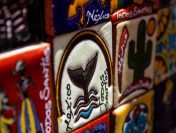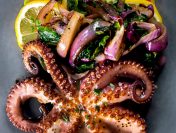Los Cabos Magazine article – Issue #10 – January 2006 – by: Sabrina Lear
For many years, México’s fiery liquor was largely confined to margaritas and shooters at the bar. Today’s fine tequilas are highly coveted by collectors worldwide—for both the smooth aromatic liquor and the handcrafted decorative bottle. While some of the unusual packaging holds tequila without pedigree, many are premium brands, selling at the top end of the market.
 México’s tequila producers, almost all located in a one hundred-mile radius of the town of Tequila in Jalisco State, distill hundreds of brands, some the old way—in small lots in tiny family-run fabricas—most in ultra-modern distilleries. Using artisans to create unique handblown glass, crystal, ceramic, and Talavera pottery bottles, savvy collectors are snapping them up like fine vintages of wine.
México’s tequila producers, almost all located in a one hundred-mile radius of the town of Tequila in Jalisco State, distill hundreds of brands, some the old way—in small lots in tiny family-run fabricas—most in ultra-modern distilleries. Using artisans to create unique handblown glass, crystal, ceramic, and Talavera pottery bottles, savvy collectors are snapping them up like fine vintages of wine.
Fine tequila is to be savored like the best cognac or single malt scotch. With production limited to the availability of blue agave, tequila’s base, prices have soared in recent years due to unprecented demand—over 50 million gallons of tequila are sold worldwide annually. With the surge in popularity and the shift to more tequila exports made of 100% Weber blue agave, more imbibers than ever are joining the list of tequila aficionados.
Tequila is North America’s first distilled spirit, and has been produced in México since shortly after the Spanish conquered the country in the early 1500s. The Spanish adapted the indigenous drink pulque, fermented from the maguey plant, into mezcal, which was eventually distilled into the tequila we drink today, using agave. Cuervo would be the first distillery to bottle tequila in the late 1900s when others were still using barrels.
Regulated by México’s Norma Oficial Mexicana since the late 1970s, each type of tequila is given a category based on age and color. Unaged tequila is called blanco (white, and also called silver), while tequila that has been colored gold with caramel is called joven abocado (bottled young)—North Americans know this as “gold.” Reposado (rested) is tequila that has aged in oak for at least two months; and añejo (aged) has aged for a year or more. To be classified as tequila, it must be made from no less than 51% Weber blue agave. High-end tequilas are made from 100% Weber blue agave, as shown on the label. A far cry from those “gold” tequila and cane sugar blends famous for agonizing hangovers, quality blancos, reposados and añejos are smooth, with many palates, depending on the production and aging process. When tequila is at its best, its stands with the finest single malt scotch and cognac.
While it’s assumed tequila is made from cactus, the blue agave is actually related to the lily. Agave reproduce small shoots around the mature plant, which are then planted in the fields—much of the tequila produced today is from original agave used in centuries past. Jimadores are the hardy men who grow agave for tequila production. They determine the time to harvest each agave from knowledge passed down through many generations of jimadores.
Agave plants need up to ten years to reach maturity and produce a 100 to 150-pound core called a piña, which is split in two and baked in large ovens, then cooled, crushed, and strained to produce a juice called agua miel, which is then fermented and distilled.
Most distilleries produce tequila blanco, reposado and añejo, along with a high-end “reserve” tequila, some selling for hundreds of dollars, bottled and packaged to reflect the tequila’s high quality.
Musician Sammy Hagar created Cabo Wabo tequila, named after his famous Cabo San Lucas nightclub. The brand evolved from trips to Tequila, around the time he was building Cabo Wabo, over fifteen years ago. Since launching a decade ago, 2004 sales of his silver, reposado, and añejo tequila, all presented in handblown bottles, exceeded the entire previous nine-year period.
Although the packaging can be seductive, it still comes down to taste. Whether you lean to the rich smooth añejos, the spicier reposados, or the more pungent blancos, discovering your favorite tequila is a journey unto itself.
Los Cabos has a number of tequila bars—Pancho’s has more than 500 bottles collected by owner John Bragg over many years and many trips throughout mainland México.
Los Garcia Restaurante, a new upscale Mexican restaurant on the marina in Plaza Puerto Paraiso, has a tequila boutique in the foyer and boasts hundreds of brands, many are exotic premium tequilas perfect for sipping as you enjoy Los Garcia’s authentic cusine. Update 2009 – Los Garcia Restaurante is now closed.
And, some tequila stores around town also offer tastings, all the better to know what you’re buying before your trip back home ¡Salud!



